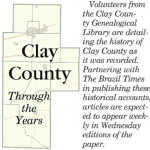- Broom-Making in Clay County (3/6/23)
- New Automobiles in 1908 (2/28/23)
- CLAY COUNTY THROUGH THE YEARS: Mt. Carmel Church (9/17/20)
- Bowling Green Flour Mill (9/10/20)
- Daugherty’s Livery Stables (8/20/20)
- Carberry Meat Market (6/5/20)
- Major Roswell Hill, Civil War Veteran and Former State Treasurer (3/31/20)

Good Hope Baptist Church
In the pioneer days of 1825, John Cooprider moved his family to the sand hill in southern Clay County. He has been given credit for being founder of Middlebury, later known as Martz, in 1836. From the time he arrived, others also started settling in the area. In was on August 28, 1838, that Good Hope Baptist Church was founded. Elias Cooprider, son of John, left an account of the beginning days, which he prepared for news publication in 1883.
The first church organization in Harrison Township was held at the home of David White, father of Ed White, a mile and half north of Clay City, which was attended by Elder William Stansel, Benjamin Kerchival, Elijah Casen, and Asa Frakes, of Prairie Creek, Zachariah McClure, and John Hodges of Union, brethren, who came for the purpose of aiding in the organization of the new class. Elder Stansel was chosen moderator and John Hodges, Clerk. David and Polly White, Joel Owen, Patsy Owen and Sophia Denny constituted the original membership of the newly organized church, which they christened “Good Hope.”
The meetings of this church were held for a time at John Denny’s, one mile west of Middlebury. About the year 1838, the log church, a fourth of a mile south of Middlebury, was built. Up to 1839, this church had no regularly installed pastor but was visited and assisted at times by William Stansel, Abraham Star, Asa Frakes, and Samuel Sparks. In 1839, the church called Elder D.B.C. Herren as the first pastor.
The first church house, which Elias referred to, was a hand-hewn log structure of 25 by 30 feet, with a fireplace in one end. It was located about a quarter mile south of Martz, near State Highway 59. The land was cleared for this structure and the building was dedicated in 1838 at the cost of $300 dollars. All labor was donated by the people of the community. They had their races, “Who could chop the best, score the most, and hew the straightest line.”
Logs that had previously been hand cut were dragged into position by oxen or mules and then hoisted by manpower into their place. While the men labored on the building, the women probably prepared corn bread from dried kernels they had recently ground. If they had meat, maybe it was roasted over an open fire. It was hearty and simple food prepared for some worthy workers. It is said that it had an “Indiana Door,” to protect the worshippers from Indian arrows. Such a door did not simply open up into the main room. The entrance was so constructed that upon going through the main door, you had to turn either to the right or the left to go further because of a protective wall, that was built to shield the worshippers from any flying arrows trying to find a human target.
In 1869, they started building the latest church edifice in the town of Middlebury. It was finished in 1873 and ready for dedication. On December 21, 1873, it was dedicated. It was said to be the largest church building in the county at that time.
Submitted by Rhonda Tincher, Clay County Genealogy Society, Center Point, Indiana.
Source: Clay City News, condensed from, “Those Were the Days” written by Shannon Walden, August 19, 2009 and The History of Good Hope Baptist Church, written by Dr. John L. Thompson.
Picture from Scot Turner.
Posting a comment requires free registration:
- If you already have an account, follow this link to login
- Otherwise, follow this link to register
